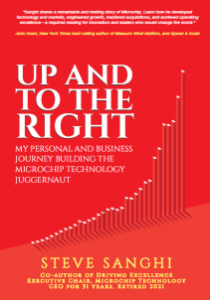Podcast: Play in new window | Download
Subscribe: Apple Podcasts | RSS

Dave talks with Steve Sanghi who was Microchip CEO for 31 years, now Executive Chair.
 Check out his new book, Up and to the Right. How Microchip was built into one of the biggest and most pofitable chip companies in the world.
Check out his new book, Up and to the Right. How Microchip was built into one of the biggest and most pofitable chip companies in the world.
In this episode we discussed:
- The early microcontrollers, ROM, EPROM, EEPROM, FLASH
- Semiconductor Fab’s and locations
- How the US Government CHIPS act is a golden handcuffs trap
- US/China rhetoric
- What really happened durign the covid supply chain crisis
- How 90% of medical devices use Microchip parts
- Lead times
- Respect for the chip manufacturers and supply chains
- Just-In-Time becomes Just-In-Case
- How the Toyota production system works and how it had to change
- The impacts of a potential war in Taiwan
- How does it make sense to make thousands of part variants?
- The secret to making part varients
- Why Microchip chose MIPS vs ARM
- Atmel didn’t make any money!
- Pricing discipline
- How buying Atmel almost didn’t happen, and how Dialog Semiconductor goofed it
- Draconian NDA terms
- Atmel was bloated
- RISC-V plans
- Customer Driven Obsolescence
- Foundry vs In-House limitations
- Open Source FPGA tools?
- Third party tool support
- Why not offer free optimised compilers?
- It’s all about black swan events, down cycles, pointy haired bosses, and how All your Cost Bases Beyong To Me
- Hobbyist vs professionals
- How Microchip is the largest aerospace chip maker in the world. Nothing leaves earth without a Microchip part in it.
- Radiation hardended parts
- Market value profitability
- Will Microchip ever get acquired
- Strained US vs China relations

Hi Dave
This was a particularly interesting episode for me. I wasn’t aware of the history of Microchip, not to mention the details of the Atmel acquisition.
I live/work in Silicon Valley, and am just minutes from Atmel, which I see every day on my commute.
Good podcast and what an amazing history Microchip has. I used to use PICs all the time.
In the early days there weren’t many C compilers for PICs, there was HiTech and it was expensive. At that time Atmels could use a free gcc compiler. I read the PICs were harder to write a C Compiler for due to their bank switching architecture.
Microchip later bought HiTech and released a free version. I read that the ‘non-optimising’ free compiler version was stuffing in extra NOP’s that bloated the code size. OK, I moved to a PIC with bigger memory. Then I found out that the free compiler didn’t support floats in printf. I could never find a place where this was documented. The least Microchip could have done is prominently explained the limitations of the free version fully and saved me a lot of time investigating why I got compile errors. That pushed me to Arduino. Then ESPxx came along with support in the Arduino IDE so there’s convenient network connectivity as well.